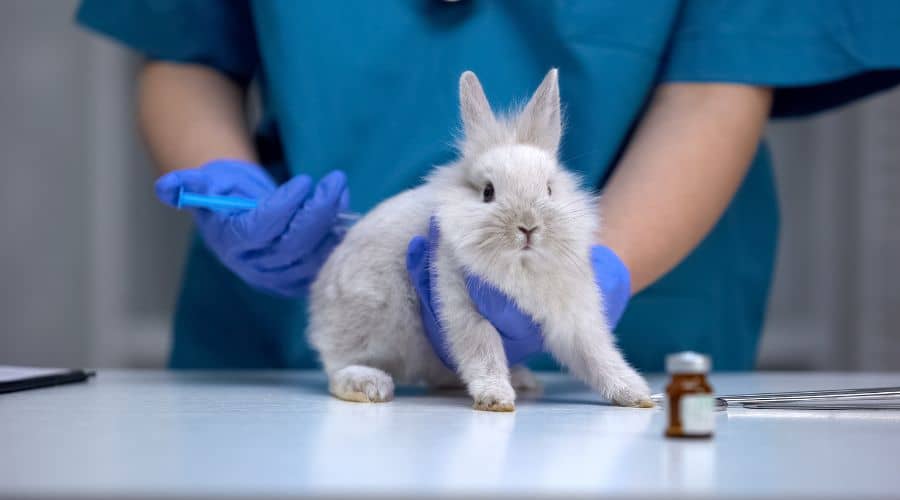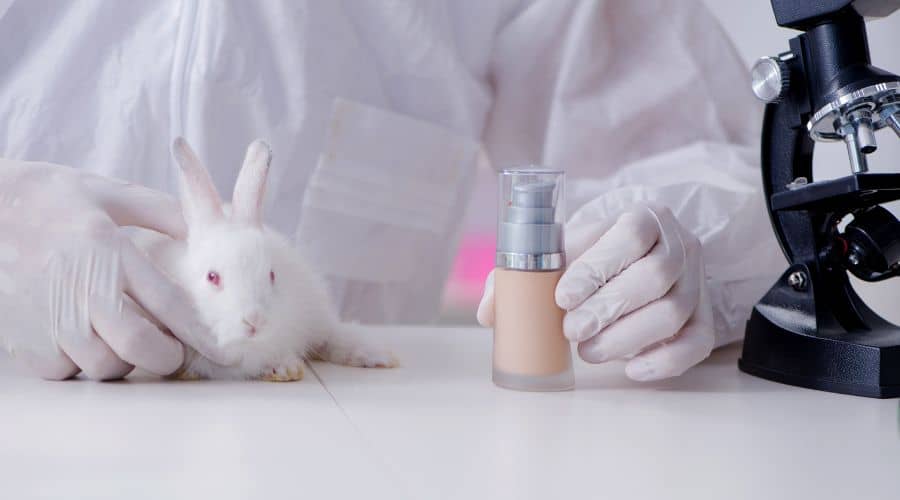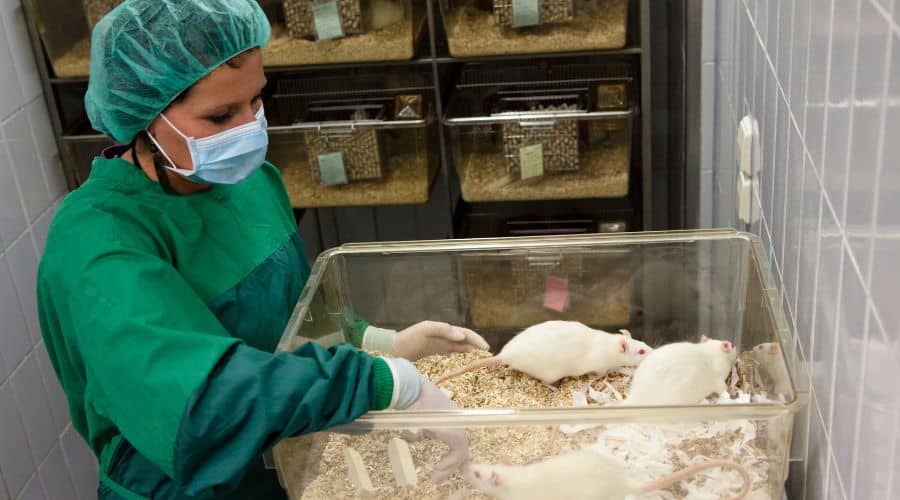
When you hear about animal testing, what comes to mind? Do you think about the animals or more about the product being tested? You’re not alone if you find yourself forgetting the ‘animal’ in animal testing. However, it’s time to pay attention because our animals are suffering and, sadly, for no tangible benefit.
Numerous laboratories around the world use animals as part of their research. This is deeply unethical. Despite being presented as a better alternative to human experimentation, animal testing is a cruel practice that might not be as useful as people think.
In this article, we’ll explain in detail what animal testing is, why it’s considered cruel, what we can do to stop animal testing, and much more.
What is Animal Testing?
Animal testing is the practice of experiments being performed on live animals for the purpose of research. This research assesses the safety and effectiveness of medicine, consumer and industrial products, and new procedures and techniques in the medical industry.
Everything from cosmetics, soap, food preservatives, painkillers, and more, can be first tested on animals before they make it to your supermarket shelf or favorite drugstore. The animals are subjected to pain, distress, and suffering even in procedures described as ‘mild.’
 Many products are tested on animals before they make it to your supermarket shelf.
Many products are tested on animals before they make it to your supermarket shelf.
Sadly, millions of animals are subjected to experiments in labs worldwide. In fact, that number is as high as 200 million per year.
So what happens to the animals after the experiments? Usually, the labs kill the animals out of a belief that no one will adopt them. Millions of animals are culled every year because of this. This is the sad reality we live in.
What is Tested on Animals?
There are three types of tests done on animals. Basic research is the most common type. Whenever researchers have scientific questions in the medical field, they use animals to try and find valuable answers. Universities are known for doing this kind of research.
The second type is the study of genetically modified animals. This growing field is where genetically modified animals are bred for specific genes. The aim is to find information that might be relevant to humans.
The final type of test done is the regulatory test. These are standard tests that determine if certain products are harmful to humans.
Before cosmetics, medicine, chemicals, and pesticides are released to the public, they’re first tested on animals to ensure that they’re not harmful and work as advertised. This process could involve testing the finished product such as lipstick or could test the chemical ingredients in a product such as a dye or preservative used to formulate that lipstick.
Learn more: Animal Testing In Makeup and Cosmetics
What Animals are Used for Testing and Experimentation?
There are a large number of animals used in animal experiments. The most common are mice, rats, monkeys, rabbits, fish, guinea pigs, horses, cows, sheep, and pigs. The Animal Welfare Act (AWA) defines an animal as a warm-blooded creature, such as dogs, cats, and monkeys. This excludes cold-blooded creatures and other creatures not considered by the AWA. A lot of unregulated testing is being subjected to animals excluded by the act.
You would think animals recognized by the AWA are free from testing. However, unfortunately, there are still regulated tests being conducted on these animals. In fact, dogs, cats, and monkeys make up 20% of the population subjected to regulated testing.
Read more: Animal Testing Facts
Types of Animal Experimentation and Testing
There are numerous experiments on animals, including:
- Eye irritancy test: This test is done by injecting a substance into one eye to assess eye irritation caused by various chemicals. The animal being tested is restrained, and its eyes are evaluated after one hour and 24-hours intervals for up to 14 days and sometimes even for three weeks. This experiment causes the animals to suffer from redness, ulcers, bleeding, and even blindness.
- Acute toxicity test: This test assesses the danger of exposure to a chemical by mouth, skin, or inhalation. Animals are exposed to such chemicals until signs of ailments or suffering appear. The animals often undergo excruciating pain, convulsions, uncontrollable seizures, and loss of motor function. They’re also killed at the end of the experiment, so an autopsy can be performed to determine internal damage.
- Skin corrosion test: The experiment determines whether a substance can cause irreversible skin damage. The test involves placing a chemical on a shaved skin patch and observing for itching, swelling, and inflammation.
- Skin sensitization test: This experiment determines if a chemical causes an allergic reaction. Animals are given multiple doses of the chemical to create an allergic reaction.
- Dermal penetration: This test analyzes a chemical’s movement through the skin and into the bloodstream.
- Mutagenicity: Chemicals are administered to the animals, who are later killed. The testers then take the animals’ bone marrow and evaluate the effects on the nucleus of the blood cells.
- Carcinogenicity test: this test involves administering orally, placing on the skin, or inhaling for two years. The animal’s health is monitored throughout the study. They’re later killed, and their tissues and organs are examined for evidence of cancer.
- Reproductive toxicity test: Involves giving pregnant female animals doses of chemicals administered orally. The animals are killed just before they deliver, and the fetuses are assessed for any sign of toxic effects of the chemicals.
All these tests either leave the animal dead or in extreme suffering.
Why Animal Testing is Bad
If it’s not obvious by now, animal testing is a callous practice. Many experiments involve injury and pain, meaning the animal suffers throughout the investigation. Even in labs that mitigate the animal’s suffering using painkillers, the animal still suffers psychological distress at being trapped and experimented on.
As if that’s not bad enough, laboratories tend to euthanize the animals after the experiment has concluded. We don’t know the exact number of animals killed due to lack of regulation. Still, it’s bound to be a considerable number.
 Laboratories tend to euthanize the animals after the experiment has concluded.
Laboratories tend to euthanize the animals after the experiment has concluded.
Putting the animals up for adoption is a solution but one with hurdles. The animals are often left physically impaired and exhibit behaviors (thanks to the trauma) that make them unpopular with pet owners.
Is Animal Testing Illegal?
Despite the cruelty involved, animal testing remains legal in most places, including the United States, where most animal experiments are unregulated, thanks to a loophole in the AWA. You would be mistaken if you thought the reason animal testing—especially on cosmetics—is so prevalent is that it’s required. However, the Federal Food, Drugs, and Cosmetics Act in fact doesn’t t require cosmetic animal testing.
Thankfully, there’s some good news. Animal testing has been partially or fully banned in over 40 countries, including Australia, Guatemala, New Zealand, South Korea, Turkey, etc. In the EU, cosmetic animal testing was banned in 2013. Seven states in the US, including Nevada, Hawaii, and New Jersey, have also passed laws banning cosmetic animal testing. There’s still a long way to go, but this is a promising start.
Should Animal Testing Be Banned?
Testing on animals is a cruel and wasteful practice that brings unnecessary suffering to our animals. Here are two mega statistics that support this:
- Over 90% of products that pass animal tests fail to reach the market.
- 92% of all the drugs tested on animals don’t even get approved for human use. This makes sense when you think about it, animals are different biologically from us, so of course, we don’t respond to medicine the same way. This means that animal testing has a massive failure rate. Keep in mind that developing these products and drugs costs millions of dollars. That’s money that could have gone to more effective research methods with better results guaranteed.
The wastefulness of animal testing isn’t the only problem. Animals have their own wants, needs, personalities, interests, and feelings. They do not exist to be used by us. Just because we humans are intelligent and capable does not give us the right to mistreat another creature for our own gain. We don’t conduct human experiments because we recognize humans as autonomous beings who deserve to be safe and happy. It’s time we see animals the same way.
What Are the Alternatives to Animal Testing?
Do alternatives to animal testing exist? Yes! There are many alternatives used by researchers, such as:
- Computer modeling – Researchers have developed sophisticated computer models of the human body. In many ways, computer models are more effective than animal tests. For example, algorithms from large chemical databases can even predict a new chemical’s toxicity. In fact, computer modeling can be used to test more chemicals than animal testing, which makes it more comprehensive.
- In vitro testing – These are tests done outside of a living organism, and they’re usually done on isolated cells, tissues, and organs. Studies have shown that in vitro testing is more effective than animal testing regarding time and precision.
- Human tissue – Human tissues can be donated through biopsies, transplants, and collected post-mortem for research purposes.
- Human volunteers – This should be carefully regulated, but using human volunteers in the early stages of research can help ensure that the product or drug being created is actually helpful to human beings.
How to Stop Animal Testing
There are things we can do to stop animal testing. The first is to only purchase cruelty-free products. These are products that haven’t been tested on animals. Companies respond when consumers talk with their wallets, so only buying cruelty-free products will significantly impact them.
 Support companies that only produce cruelty free products.
Support companies that only produce cruelty free products.
Look for cruelty-free certifications from Cruelty-Free International, Leaping Bunny, and Beauty Without Bunnies. These organizations have online databases and mobile apps to make it easy to see if a product is cruelty-free.
You can also pressure your representatives to support legislation that ends animal use in experiments.
Animal testing is still widely practiced around the world. Products and procedures for humans are first tested on animals to ensure they’re safe. Still, so far, there have been no real benefits to animal testing.
These tests cost millions of dollars and usually fail because of the biological differences between animals and humans. Despite this, millions of animals needlessly suffer through experiments that cause them physical and psychological harm. Thankfully, some signs indicate things are changing, and we’re starting to care more for animal rights just as we care about our safety.
Interested in animal welfare? Learn more about issues facing animals, such as animal extinction.
You Might Also Like:

![]() Stella - Writer
Stella - Writer
Stella is a writer and mother from Thika, Kenya.
Her love for nature and the beautiful Kenyan outdoors has inspired Stella to consciously make an effort to lead a more sustainable, eco-friendly lifestyle.


